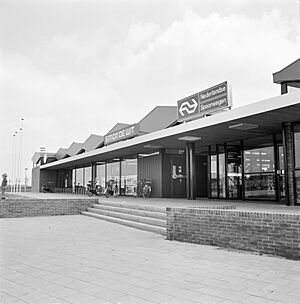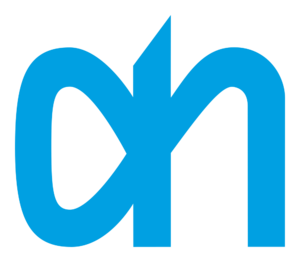Albert Heijn facts for kids
| Industry | retail, retail chain |
|---|---|
| Founded | 27 May 1887 |
| Founder | Albert Heijn |
| Headquarters | , |
|
Number of locations
|
1056 |
|
Area served
|
Netherlands Belgium |
|
Key people
|
Marit van Egmond (CEO) |
| Products | Supermarkets, Convenience stores, Small hypermarkets |
|
Number of employees
|
125,000 |
| Parent | Ahold Delhaize |
Albert Heijn, often called AH or Appie, is the biggest supermarket chain in the Netherlands. It holds a large part of the market, about 37.7% in 2024. This company started in 1887 and has been part of a bigger group called Ahold Delhaize since 2016.
The Story of Albert Heijn
The Albert Heijn company began on May 27, 1887. A man named Albert Heijn bought a small grocery store from his father in a town called Oostzaan. Over the next few years, Albert Heijn opened more stores in different cities. By 1899, he had a main warehouse in Zaandam to store all his products.
How Albert Heijn Started Making Its Own Products
Around 1895, Albert Heijn started roasting his own coffee. He did this in a laundry room at his Oostzaan store! By 1910, the company was making other things too, like candy, cakes, and pastries. At first, these were made in an old house in Zaandam. But in 1913, they built a proper factory there.
In 1920, all the different parts of the business were put together into one big company. Albert Heijn then handed over control of the company to his sons, Gerrit Heijn and Jan Heijn, and his son-in-law, Johan Hille. Albert Heijn himself stayed on as the head of the board.
Growing Bigger and Going Public
Albert Heijn's business grew because more people had steady jobs and money. People's eating habits also changed, and they wanted new types of food. With more factories making packaged goods, special products became easier for everyone to buy.
In 1948, Albert Heijn became a public company. This means people could buy shares in the company. The 1950s brought two big changes. In 1952, they opened their first self-service store, where customers could pick their own items. Then, in 1955, they opened their very first supermarket.
Albert Heijn became the largest supermarket chain in the Netherlands by buying other companies. Some important ones they bought were Van Amerongen in 1950, Simon de Wit in 1972, and parts of C1000 in 2008 and 2012.
In 1973, Albert Heijn became part of a new company called Ahold NV. This helped Albert Heijn's parent company expand into other countries.
Changing Prices and Expanding Abroad
In early 2003, Albert Heijn noticed that fewer people were shopping there. To get customers back and change its image of being expensive, Albert Heijn started lowering prices on thousands of items. By the end of 2006, they had successfully reduced the price difference with other stores. Their market share grew to almost 30%.
In 2007, Albert Heijn opened a store in Curaçao, which is an island in the Caribbean. This store stayed open until 2016. In 2011, the company opened its first store in Belgium. Even though Ahold (Albert Heijn's parent company) merged with Delhaize, both Albert Heijn and Delhaize stores still operate in Belgium. Today, Albert Heijn has 60 stores there. They also tried opening smaller "AH To Go" stores in Germany, but this ended in 2018.
Simon de Wit Supermarkets

Simon de Wit was a large family-owned chain of supermarkets in the Netherlands. It was started by Simon de Wit in 1867. He opened a grocery store from his family home. By 1888, he had his first store in Amsterdam. By 1900, he had 30 stores and a main warehouse in Zaandam.
In 1970, a fire destroyed Simon de Wit's main warehouse. Soon after, Albert Heijn became interested in buying the company. In 1973, Simon de Wit merged with Albert Heijn. All the Simon de Wit stores then changed their name to Albert Heijn.
Types of Albert Heijn Stores
Albert Heijn Stores
This is the most common type of Albert Heijn store you'll find in the Netherlands and Belgium. Since 2018, Albert Heijn has been updating these stores with a new idea called "Echt Vers" (which means "Really Fresh"). These updated stores offer 10–15% more fresh fruits, vegetables, and other fresh foods.
Albert Heijn also focuses on offering more organic and eco-friendly products. They are working to use less plastic and build stores and transport goods in ways that are better for the environment. They also try to reduce food waste.
AH To Go Stores
In 1999, Albert Heijn created a new type of small store called a convenience store. These stores were designed for people who are traveling, like at train stations. The stores got their current name, AH To Go, in 2001. They sell things that customers might need quickly on their way to work or school.
Since 2019, Albert Heijn has been trying out a new kind of AH To Go store. These stores don't have staff or cash registers! Customers scan their debit card to enter. Cameras then watch what items they pick up. When the customer leaves, the correct amount is automatically taken from their bank account. This new technology was tested in a special mobile unit.
AH XL Stores
Since 2002, Albert Heijn has also operated larger stores called hypermarkets, known as AH XL. These stores are much bigger and offer a wider range of products, including both food and non-food items. Inside these stores, you can even find chefs preparing ready-to-eat meals. These large stores often take up an entire floor in a building.
Albert Heijn Online Shopping
Albert Heijn started testing grocery delivery in 1999. This service was first called Albert Heijn Thuisservice, then Albert.nl. Through this service, customers could order groceries and products from other related stores. In 2014, the Albert brand was stopped, and the delivery service became part of the main Albert Heijn brand.
Where Albert Heijn Works
Since 1899, the main office of Albert Heijn has been in Zaandam, Netherlands. Their parent company, Ahold Delhaize, is also located there. Albert Heijn has six large distribution centers where products are stored and sent out to stores. These are in Nieuwegein, Geldermalsen, Zaandam, Tilburg, Pijnacker, and Zwolle.
Besides their many stores, Albert Heijn also has seven "Home Shop Centers." These are places where online orders are put together for delivery to customers' homes. They are located in Almere, Eindhoven, Rotterdam, De Meern, Amsterdam, Oosterhout, and Bleiswijk.
In 2014, the Albert Heijn brand was valued at 866 million dollars. This made it one of the top brands in Europe.
See also
- Ahold Delhaize
- List of supermarket chains in the Netherlands




